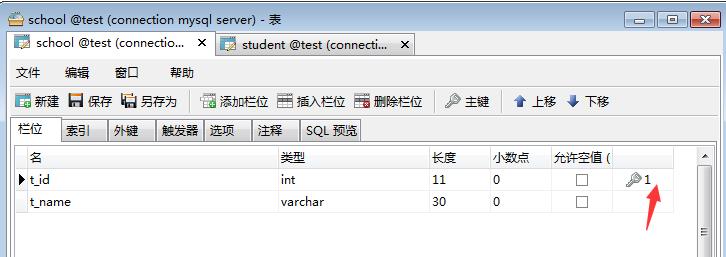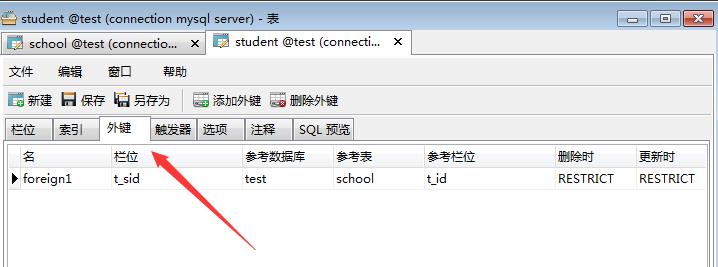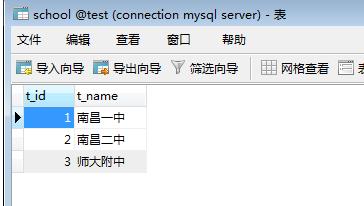Mybatis关联映射
Posted Hawk喵
tags:
篇首语:本文由小常识网(cha138.com)小编为大家整理,主要介绍了Mybatis关联映射相关的知识,希望对你有一定的参考价值。
一. Mybatis关联映射
1 讲数据库中关联关系,主键表与外键表
一对多,多对一,主键表表示一 与外键表表示多
学生与学校的关系,工人与工厂,人员与部门的关系,。。。。
多 一 多 一 多 一





2 多表查询
多表查询 方法一
select a.*,b.* from student a,school b where a.t_sid=b.t_id
select a.*,b.t_name from student a,school b where a.t_sid=b.t_id
select a.*,b.t_name from student a,school b where a.t_sid=b.t_id and b.t_id=1
多表查询 方法二
select student.*,school.* from student inner join school on student.t_sid=school.t_id
select student.*,school.t_name from student inner join school on student.t_sid=school.t_id
select student.*,school.t_name from student inner join school on student.t_sid=school.t_id and school.t_id=1
3 mybatis多对一
要查询多个表中信息:有三种方法:
方法一:
<resultMap type="com.softjx.model.Student" id="StudentMap1"> <result column="t_id" property="id"/> <result column="t_name" property="studentName" /> <result column="t_age" property="age"/> <result column="t_enterdate" property="enterDate"/> <result column="t_sid" property="sid"/> <!—关联字段--> <result column="t_id1" property="school.id"/> <result column="t_name1" property="school.schoolName"/> </resultMap> <!-- 根据id查询数据表中的一条记录 --> <select id="getStudentId1" resultMap="StudentMap1"> select a.t_id,a.t_name,a.t_age,a.t_enterdate,a.t_sid,b.t_id as t_id1,b.t_name as t_name1 from student a,school b where a.t_sid=b.t_id and a.t_id=#{id}; </select>
方法二:使用association定义关联的单个对象
<resultMap type="com.softjx.model.Student" id="StudentMap2"> <result column="t_id" property="id"/> <result column="t_name" property="studentName" /> <result column="t_age" property="age"/> <result column="t_enterdate" property="enterDate"/> <result column="t_sid" property="sid"/> <!-- association可以指定联合的javaBean对象 property="school":指定哪个属性是联合的对象 javaType:指定这个属性对象的类型[不能省略] --> <association property="school" javaType="com.softjx.model.School"> <id column="t_id" property="id"/> <result column="t_name" property="schoolName"/> </association> </resultMap> <!-- 根据id查询数据表中的一条记录 --> <select id="getStudentId2" resultMap="StudentMap2"> select a.t_id,a.t_name,a.t_age,a.t_enterdate,a.t_sid,b.t_id as t_id1,b.t_name as t_name1 from student a,school b where a.t_sid=b.t_id and a.t_id=#{id}; </select>
方法三:使用association进行分步查询
1)、先按照t_id查询学生信息
2)、根据查询学生信息中的t_sid值去学校表查出学校的信息
3)、学校信息设置到学生中;
1、先按照t_id查询学生信息 2、根据查询学生信息中的t_sid值去学校表查出学校的信息 3、学校信息设置到学生中; <resultMap type="com.softjx.model.Student" id="StudentMap3"> <result column="t_id" property="id"/> <result column="t_name" property="studentName" /> <result column="t_age" property="age"/> <result column="t_enterdate" property="enterDate"/> <result column="t_sid" property="sid"/> <!-- association定义关联对象的封装 select:表明当前属性再去调用哪个方法查出的结果 column:指定根据当前表中哪一列的值传给这个方法 流程:使用select指定的方法查出对象,并封装给property指定的属性 --> <association property="school" select="com.softjx.dao.SchoolMapper.getSchoolId" column="t_sid"> </association> </resultMap>
使用association进行分步查询,可以是立即加载,延迟加载;
可以使用延迟加载(懒加载);(按需加载)
Student==>School:
我们每次查询Student对象的时候,都将一起查询出来,(立即加载)。
学校信息在我们使用的时候再去查询(延迟加载);
分段查询的基础之上(懒加载)加上两个配置在全局配置文件中config.xml:
<settings> <setting name="lazyLoadingEnabled" value="true"/> <setting name="aggressiveLazyLoading" value="false"/> </settings>
4 mybatis一对多
方法一:使用collection标签
1)在学校中有一个集合类型,指向多个学生
private List<Student> students; public List<Student> getStudents() { return students; } public void setStudents(List<Student> students) { this.students = students; }
2)在SchoolMapper.xml文件中配置collection标签,标签中ofType:指定集合里面元素的类型,property:指定bean的属性名。
<resultMap type="com.softjx.model.School" id="SchoolMap1"> <result column="t_id" property="id"/> <result column="t_name" property="schoolName" /> <!-- collection定义关联集合类型的属性 ofType:指定集合里面元素的类型 --> <collection property="students" ofType="com.softjx.model.Student"> <!-- 定义这个集合中元素的封装规则 --> <result column="t_id1" property="id"/> <result column="t_name1" property="studentName" /> <result column="t_age" property="age"/> <result column="t_enterdate" property="enterDate"/> <result column="t_sid" property="sid"/> </collection> </resultMap> <select id="getSchoolId1" resultMap="SchoolMap1"> select b.t_id as t_id,b.t_name as t_name ,a.t_id as t_id1 ,a.t_name as t_name1,a.t_age,a.t_enterdate, a.t_sid from school b, student a where b.t_id=a.t_sid and b.t_id=#{id} </select>
方法二:使用collection分段:
1)首先要根据学校编号在学生表中查询所有学生:
<!-- 根据学生的学校id查询所有的学生 --> public List<Student> getStudentsBySchoolId(Integer sid); <select id="getStudentsBySchoolId" resultMap="StudentMap"> select * from student where t_sid=#{sid}; </select> 注意:这个sid是collection标签中要访问的。
2)Collection分段代码:
<!-- sid是方法的参数名,t_id是字段名 --> <resultMap type="com.softjx.model.School" id="SchoolMap2"> <result column="t_id" property="id"/> <result column="t_name" property="schoolName" /> <collection property="students" select="com.softjx.dao.StudentMapper.getStudentsBySchoolId" column="{sid=t_id}" fetchType="lazy"> </collection> </resultMap> <select id="getSchoolId2" resultMap="SchoolMap2"> select * from school where t_id=#{id} </select>
注意:
1)fetchType="lazy":表示使用延迟加载,默认是延迟;它的取值是 lazy:延迟加载,eager:立即加载。
2)多列的值传递:
column="{key1=column1,key2=column2}",key1是方法的参数名,column1是字段名, key2是方法的参数名,column2是字段名。
5 mybatis一对多,多对一(使用注解)
1)mybatis全局配置文件要应用接口类:
<mappers> <mapper class="com.softjx.dao.SchoolMapper"/> <mapper class="com.softjx.dao.StudentMapper"/> </mappers>
2)没有mapper.xml文件,只有接口文件:
多对一关系:
//根据id查询学生,包括学生的学校 //property="school",column="t_sid" column是当前表中关联字段名t_sid //查询一个用户 @Select("select * from student where t_id=#{id}") @Results({@Result(property="id",column="t_id") ,@Result(property="studentName",column="t_name") ,@Result(property="age",column="t_age") ,@Result(property="enterDate",column="t_enterdate") ,@Result(property="sid",column="t_sid") ,@Result(property="school",column="t_sid",one=@One(select="com.softjx.dao.SchoolMapper.getSchoolId",fetchType=FetchType.EAGER)) }) public Student getStudentId1(Integer id);
一对多的关系:
1.先要在多这一方查询数据。 //根据学生的学校id查询所有的学生 @Select("select * from student where t_sid=#{sid}") @Results({@Result(property="id",column="t_id") ,@Result(property="studentName",column="t_name") ,@Result(property="age",column="t_age") ,@Result(property="enterDate",column="t_enterdate") ,@Result(property="sid",column="t_sid") }) public List<Student> getStudentsBySchoolId(Integer sid); 2. //根据id查询学校 //property="students",column="t_id" column是当前表中的主键字段名t_id @Select("select * from school where t_id=#{id}") @Results({@Result(property="id",column="t_id") ,@Result(property="schoolName",column="t_name") ,@Result(property="students",column="t_id",many=@Many(select="com.softjx.dao.StudentMapper.getStudentsBySchoolId",fetchType=FetchType.LAZY)) }) public School getSchoolId1(Integer id);
以上是关于Mybatis关联映射的主要内容,如果未能解决你的问题,请参考以下文章